|
1832 ... : Shakuhachi & Komusō "History" Narratives
Written and Publicized in Western Languages
BEFORE 1945?
Well, to be completely truthful and factual, Post-WW2 historians and japanologists publishing in Western languages about the shakuhachi,
its history and music, did indeed base themselves quite substantially on these initially presented pre-WW2 sources that first appeared in print:
In Dutch & German as early as in 1832,
in English in London in 1861,
in German in Berlin in 1864,
in English in London in 1867,
in German in Leipzig in 1874,
in English in London in 1893,
in English in Tokyo in 1895,
in French in Hongkong in 1899,
in English in New York in 1910,
in English in London in 1935,
twice in English in Tokyo in 1936,
respectively - for better, or for worse, that is ...
AND, first of all - simply speaking:
You will not find any references, whatsoever, to neither 'Suizen', nor "Shakuhachi Meditation",
in any of these anyhow fascinating and thought-provoking texts.
Period!
PHILIPP FRANZ BALTHASAR von SIEBOLD - 1832
Quotation from Philipp Franz Balthasar von Siebold: Nippon.
Archiv Zur Beschreibung Von Japan Und Dessen Neben - Und Schutzländern.
Jezo Mit Den Südlichen Kurilen, Krafto, Kooraï Und Den Liukiu-Inseln,
nach japanischen und europäischen Schriften und eigenen Beobachtungen.
Leyden: bei dem Verf.; Amsterdam: Muller; Leyden: Hoek; Leyden: Lau, 1832.
Link: http://digital.bibliothek.uni-halle.de/hd/content/titleinfo/977570
"Pelgrims. Pilger,
Komusō m.d. Sjak'hata
Rokubu m.b. Tatakikane"

'Komusō' "Pelgrims/Pilger" in Philipp Franz Balthasar von Siebold's "Nippon",
Tafelband 2, first published in 1832.
Among many other places, in the collection of The Royal Libray, Copenhagen, Denmark.
GEORGE SMITH – 1861
Quotation from George Smith: Ten Weeks in Japan.
Longman, Green, Longman and Roberts, London, 1861.
Link: https://books.google.dk/books?id=jdkMAAAAIAAJ&printsec=frontcover&hl=da#v=onepage&q&f=false
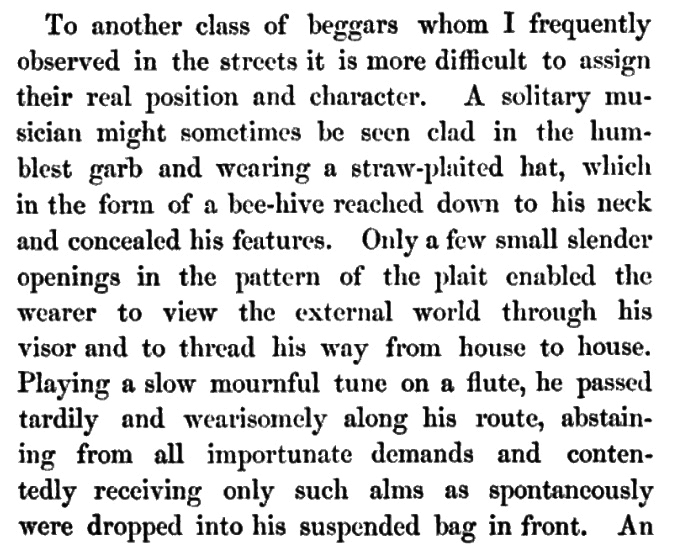
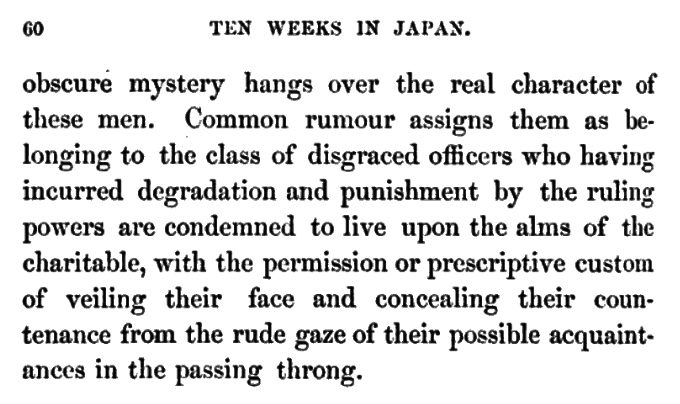
Pages 59-60 in George Smith's "Ten Weeks in Japan".
"To another class of beggars whom I frequently observed in the streets it is more difficult to assign their real position and character.
A solitary musician might sometimes be seen clad in the humblest garb and wearing a straw-plaited hat, which in the form of a bee-hive reached down to his neck and concealed his features.
Only a small slender openings in the pattern of the plait enabled the wearer to view the eternal world through his visor and to thread his way from house to house.
Playing a slow mournful tune on a flute, he passed tardily and wearisomely along his route, abstaining from all importunate demands
and contendedly receiving only such alms as spontaneously were dropped into his suspended bag in front.
An obscure mystery hangs over the real character of these men.
Common rumour assigns them as belonging to the class of disgraced officers who having incurred degradation and punishment by the ruling powers
are condemned to live upon the alms of the charitable, with the permission or prescriptive custom of veiling their face and concealing their countenance
from the rude gaze of their possible acquaintances in the passing throng."
Quoted from pages 59-60.
GUSTAV ADOLF SPIEß - 1864
FRIEDRICH STEGER - 1874
Quotation from Gustav Adolf Spieß: Die Preußische Expedition nach Ostasien während der Jahre 1860-1862:
Reise-Skizzen aus Japan, China, Siam und der Indischen Inselwelt.
O. Spamer, Berlin, 1864, 428 pages, ill.
Link: https://babel.hathitrust.org/cgi/pt?id=uc1.$b808750;view=1up;seq=12
The same text quoted in Friedrich Steger, Eduard Hintze & Hermann Wagner, editors:
Das alte und das neue Japan, oder, Die Nippon-Fahrer:
In Schilderungen der bekanntesten älteren und neueren Reisen/
Ursprünglich bearbeitet von Friedrich Steger und Hermann Wagner;
Neu hrsg. von Eduard Hintze.
3. edition, O. Spamer, Leipzig, 1874, 494 pages, ill.
Link: https://babel.hathitrust.org/cgi/pt?id=coo.31924023219730;view=1up;seq=10

Text about 'komusō' in Steger, 1874, page 386
"Eine eigenthümliche Erscheinung ist es, in den Straßen Jedo's jene Bettler zu erblicken, die mit verhülltem Gesichte von Haus zu Haus ziehen.
Sie tragen nämlich einen cylinderförmigen Korb von Bambusgeflecht über den Kopf gezogen, der bis ans Kinn hinabreicht und ihr ganzes´s Gesicht verdeckt,
während sie selbst durch ein Flechtwerk zu sehen vermögen.
Sie blasen meist eine Klarinette, reden indeß kein Wort.
Man hält sie zuerst für eine besondere Sekte Priester, hört dann aber, daß es degradirte Beamte sind, die vom Mikado die erlaubnis erhalten haben,
sie auf diese Weise ihren Lebensunterhalt zu erbetteln und, um nicht erkannt zu werden, jenen Korb tragen.
Die Zahl der privilegirten Almosensammler ist in Jedo allein nach Tausenden zu zählen."

"Japanischer Bettler als Klarinettbläser"
Komusō in Gustav A. Spieß, 1864, page 201
"It is some strange sight to observe those beggars moving from house to house with hidden faces.
They are namely wearing a cylinder shaped basket made of plaited bamboo pulled over the head, that reaches down to the chin and hides the entire face
while they are themselves capable of looking out through a braided grid.
They usually blow a clarinet while not uttering a single word.
You assume them first to be priests of a special sect but then hear that they are degraded officers who have been given permission by the Emperor
to beg for their livelihood in this manner and in order not to be recognized to wear that basket.
The number of authorized alms collectors in Jedo alone runs into thousands."
English translation by Torsten Olafsson
Spieß, 1864: Picture page 202, text pages 202-203.
Steger, 1874: Picture page 387, text page 386.
JACOB MORTIMER WIER SILVER - 1867
Quotation from J.M.W. Silver/Jacob Mortimer Wier Silver:
Sketches of Japanese Manners and Customs.
Illustrated by Native Drawings, Reproduced in Fac-simile
by Means of Chromo-lithography, published in London in 1867.
Links: https://archive.org/details/sketchesofjapane00silvrich/page/22/mode/2up
https://archive.org/details/sketchesofjapane00silvrich
The Project Gutenburg link: https://www.gutenberg.org/cache/epub/13051/pg13051-images.html
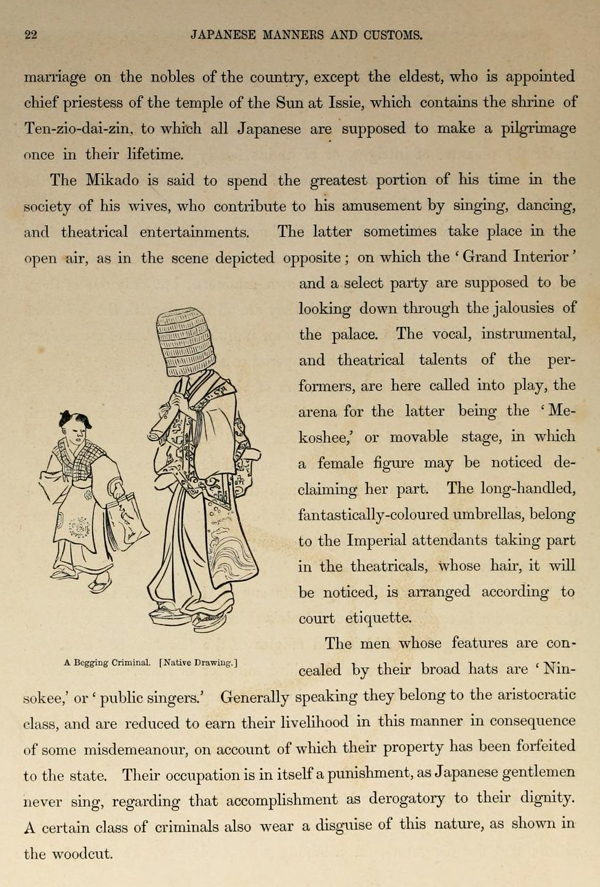
xxx.
"A Begging Criminal. (Native Drawing.)"
"A certain class of criminals also wear a disguise of this nature, as shown in the woodcut.."
Quoted from page 22, one sentence at the page bottom.
FRANCIS TAYLOR PIGGOTT - 1893, 1909 ...
Quotation from Francis Taylor Piggott: The Music and Musical Instruments of Japan
with notes by T.L. Southgate. London, 1893 - 1909, 1969, 1971.
Download link: https://www.scribd.com/document/93746164/Music-and-Musical-Instruments-of-Japan
Link to PDF file:
The Music and Musical Instruments of Japan, PDF file
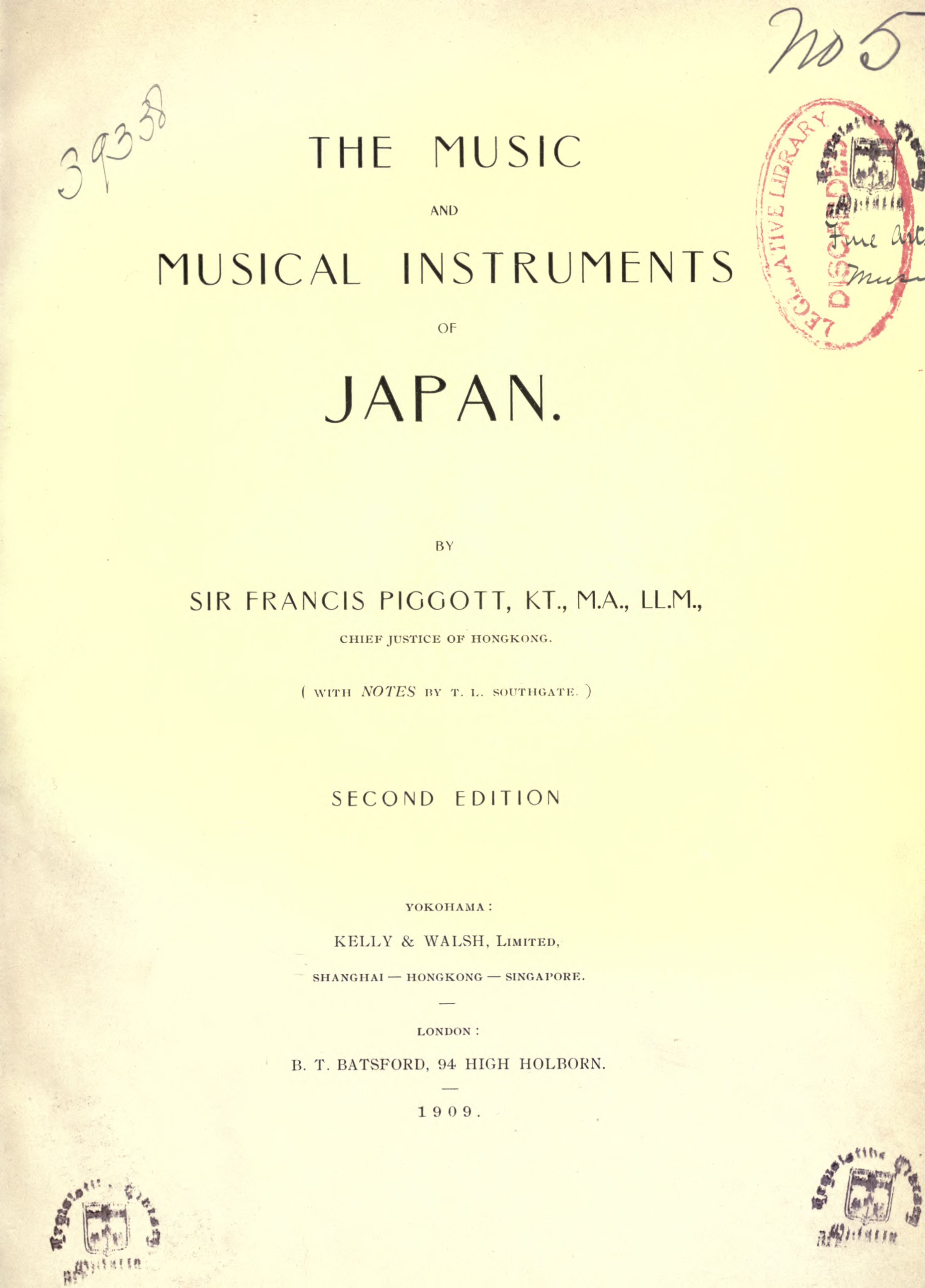
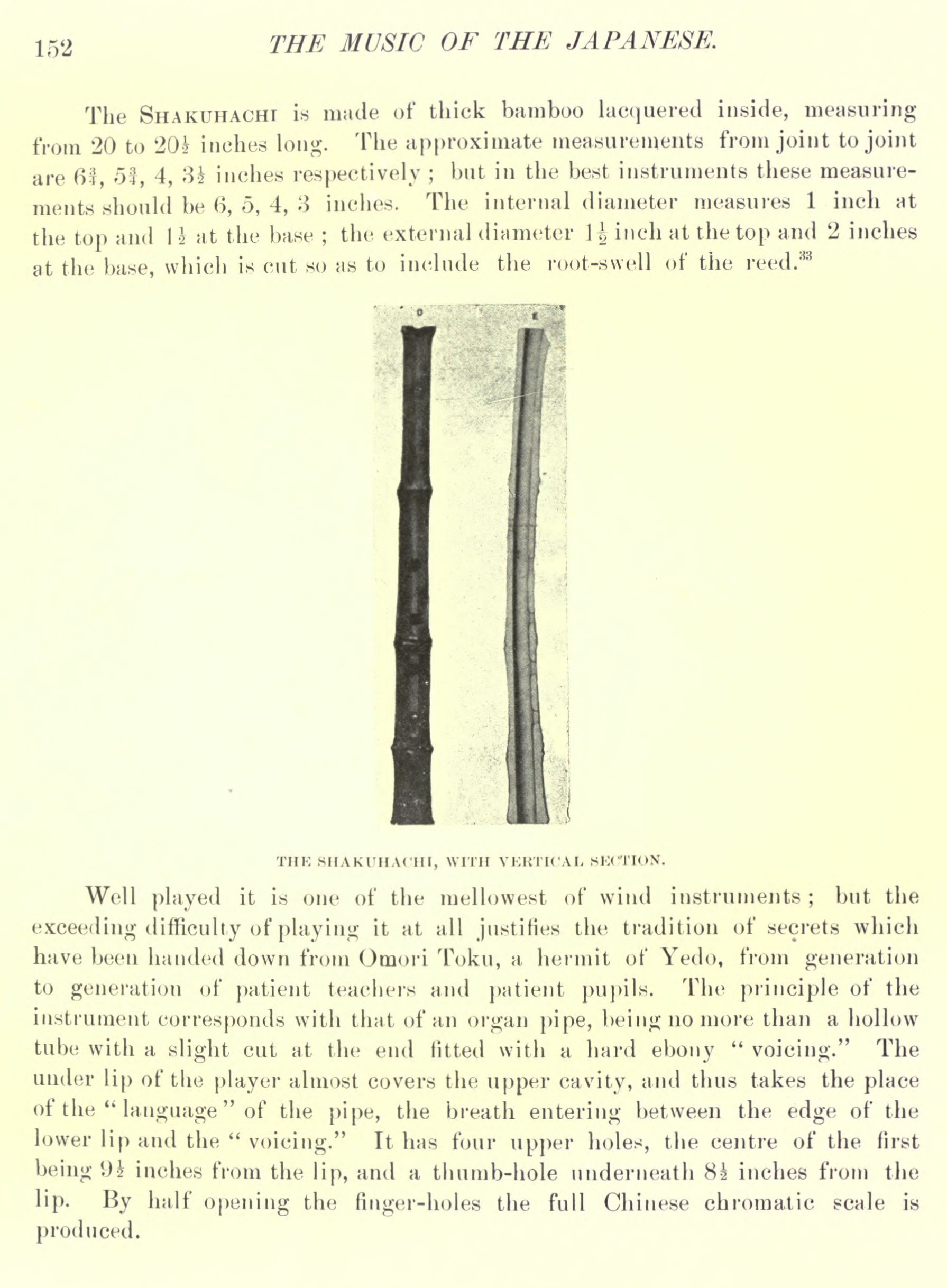
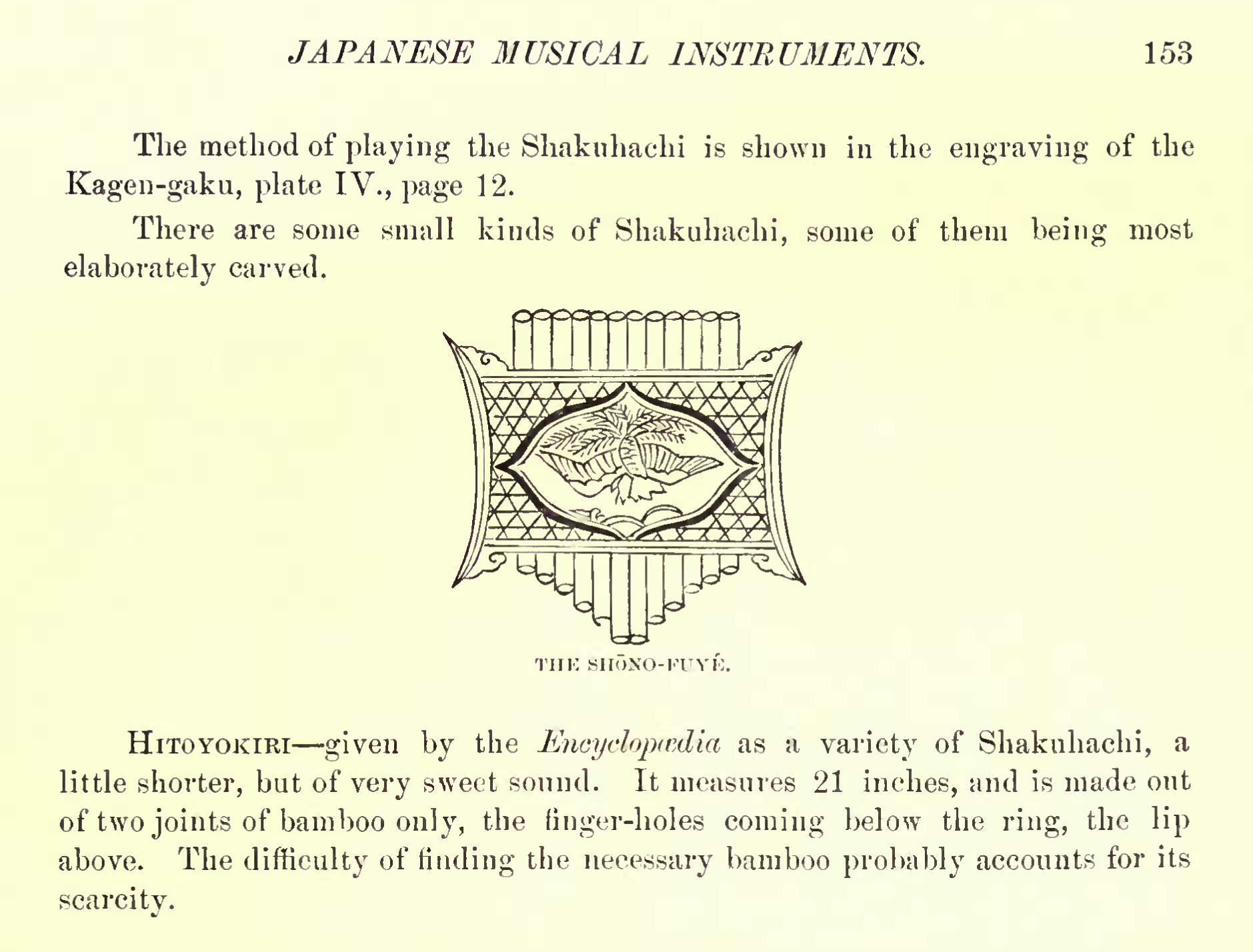
Title page and pages 152-153 in the F.T. Piggott 1909 edition.
"The Shakuhachi is made of thick bamboo lacquered inside, measuring from 20 to 20½ inches long.
The approximate measurements from joint to joint are 6¾, 5¾, 4, 3½ inches respectively; but in the best instruments these measurements should be 6, 5, 4, 3 inches.
The internal diameter measures 1 inch at the top and 1½ at the base, which is cut so as to include the root-swell of the reed.
Well played it is one of the mellowest of wind instruments; but the exceeding difficulty of playing it at all justifies the tradition of secrets
which have been handed down from Omori Toku, a hermit of Yedo, from generation to generation of patient teachers and patient pupils.
The principle of the instrument corresponds with that of an organ pipe, being no more than a hollow tube with a single cut at the end fitted with a hard ebony "voicing."
The under lip of the player almost covers the upper cavity, and thus takes the place of the "language" af the pipe,
the breath entering between the edge of the lower lip and the "voicing."
It has four upper holes, the centre of the first being 9½ inches from the lip, and a thumb-hole underneath 8½ inches from the lip.
By half opening the finger-holes the full Chinese chromatic scale is produced."
Quoted from page 152.
MISS DULCIE HARMONY - 1895, 1897:
Quotation from Miss Dulcie Harmony: Musical Japan
Publ. by Akiyama Aisaburo, Tokyo, 1895 (1897).
Link: https://www.bakumatsuya.com/shop-description.php?ID=1628863865&La=E#here
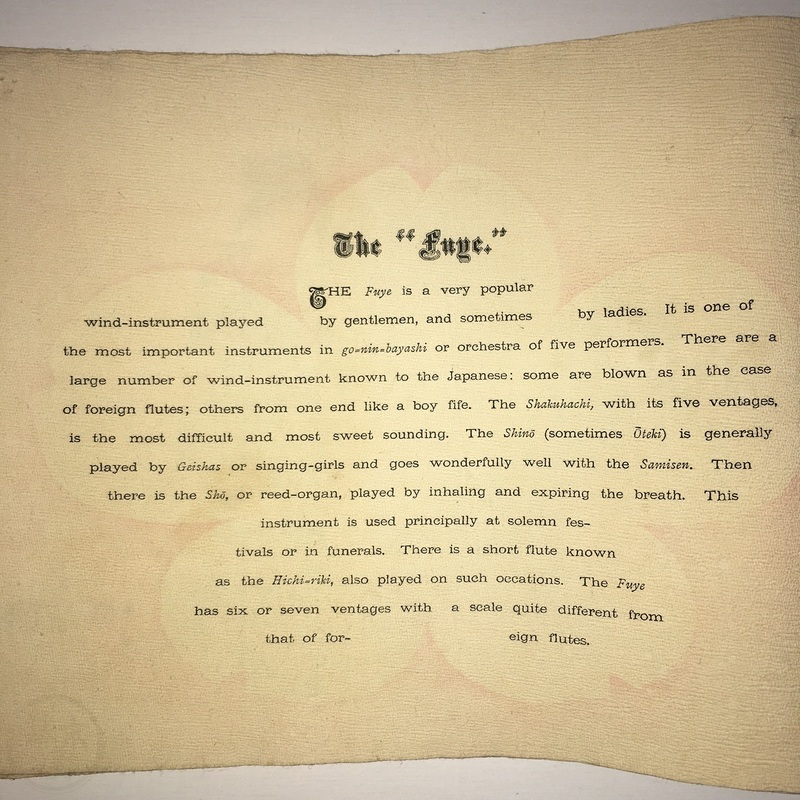
Page 15 in Miss Dulcie Harmony's book "Musical Japan", 1895
"The Shakuhachi with its five ventages, is the most difficult and the most sweet sounding."
Quoted from page 15.
EDMOND PAPINOT - 1899 & 1906
Edmond Papinot: Dictionnaire japonais-francais des noms principaux de
l'histoire et de la géographie du Japon suivi de
17 appendices sur les empereurs, shōgun, nengō,
sectes bouddhistes, provinces, départements, mesures, etc.
Hongkong, 1899.

Page 120 in Edmond Papinot's 1899 book
"Fuke-shū,
普化宗
Branche de la secte Zen, fondée par le bonze chinois Fuke-Zenji.
En 1248, le bonze Kakushin se rendit en Chine, où le fameux Busshō-Zenji, du temple Gokoku-ji, lui enseigna les doctrines de la secte.
Il y avait alors dans ce temple un certain Chōyū, très habile à jouer de la flûte (shakuhachi) :
Kakushin reçut des leçons de lui et, à son retour au Japon (1254), se mit à parcourir le pays en jouant de la flûte et en prêchant.
Ses successeurs, Kichiku, Komu, firent de même, et le nom de ce dernier, Komu-sō, est devenu le terme générique par lequel on désigna les bonzes ambulants de la secte.
Sous les Tokugawa, les samurai en rupture de ban s'enrôlèrent en grand nombre dans le Fuke-shū et, revêtus du costume traditionnel, coiffés d'un large chapeau qui leur cachait le visage, se mirent à parcourir le pays, quêtant, en jouant de la flûte.
Pour échapper à la justice ou à la surveillance du shôgunat, il devint d'usage de s'affilier aux komusō et, des désordres s'étant produits, Ieyasu édicta un règlement pour fixer leurs privilèges et leurs obligations.
La secte compta 73 temples, ayant pour centre l'Ichigetsu-ji, à Koganei (Shimōsa).
Elle fut interdite à la Restauration.”
Quoted from page 120.
EDMOND PAPINOT - 1910 & 1964 in English
Edmond Papinot & Terence Barrow: Historical and geographical dictionary of Japan,
with an introduction to the new edition by Terence Barrow.
Tuttle Publishing, Rutland, Vermont, 1989.
First edition in English translation by Terence Barrow publ. in 1910.
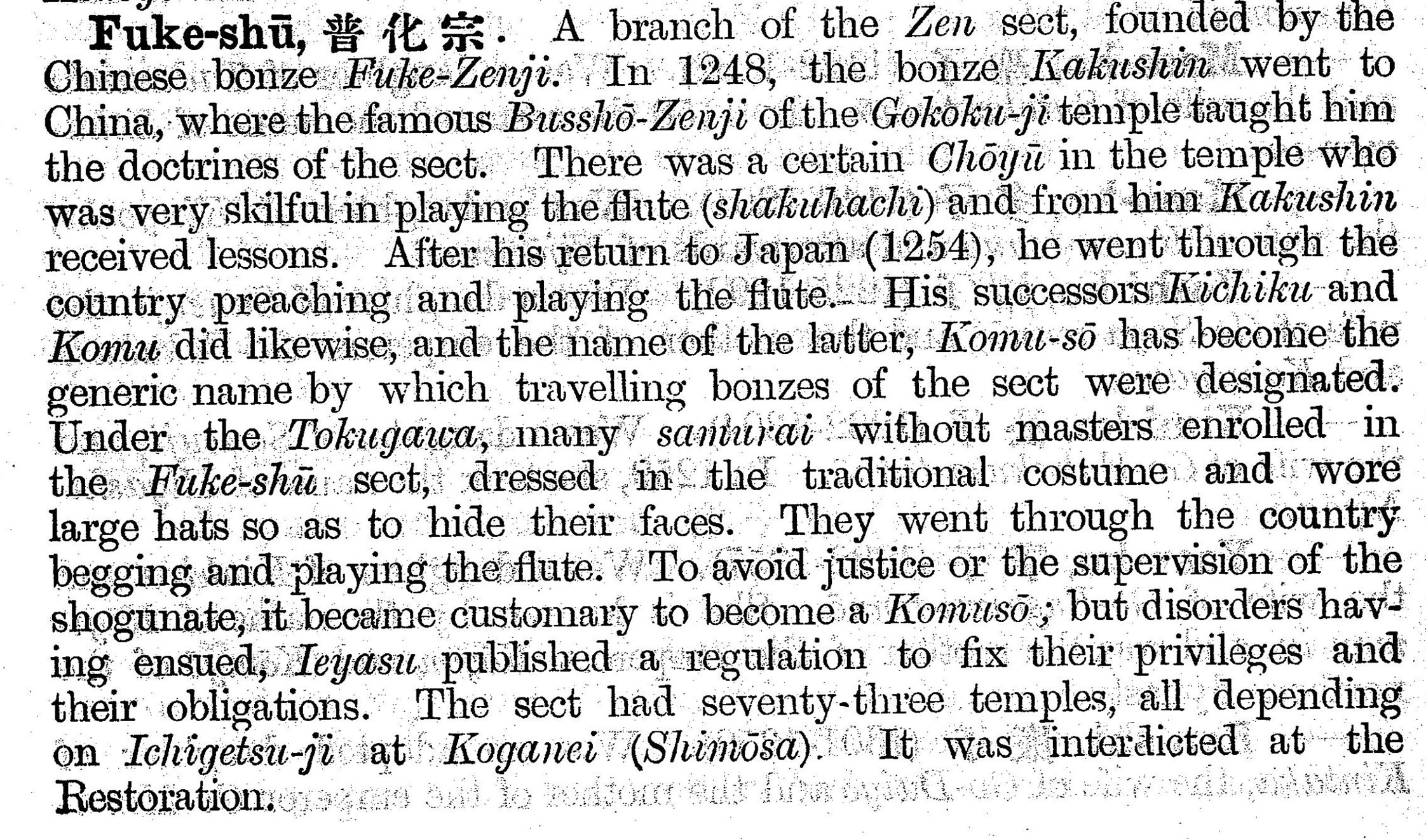
English translation of Edmond Papiniot's 1899 text
According to Edmond Papinot, writing in 1899 in French, here translated to English by Terrence Barrow:
"Fuke-shū, 普化宗.
A branch of the Zen sect, founded by the Chinese bonze Fuke-Zenji.
In 1248, the bonze Kakushin went to China, where the famous Busshō-Zenji of the Gokoku-ji temple taught him the doctrines of the sect.
There was a certain Chōyū in the temple who was very skilful in playing the flute (shakuhachi) and from him Kakushin received lessons.
After his return to Japan (1254), he went through the country preaching and playing the flute.
His successors Kichiku and Komu did likewise, and the name of the latter, Komu-sō has become the generic name by which
travelling bonzes of the sect were designated.
Under the Tokugawa, many samurai without masters enrolled in the Fuke-shū sect, dressed in the traditional costume and wore large hats
so as to hide their faces.
They went through the country begging and playing the flute.
To avoid justice or the supervision of the shogunate, it became customary to become a Komusō;
but disorders having ensued, Ieyasu published a regulation to fix their privileges and their obligations.
The sect has seventy-three temples, all depending on Ichigetsu-ji at Koganei (Shimōsa).
It was interdicted at the Restoration."
SIR CHARLES ELIOT - 1935 & 1964
Quotation from Sir Charles Eliot's book titled "Japanese Buddhism."
Edward Arnold & Co., London, 1935.
3rd impression, Routledge and Kegan Paul, London, 1964.
"In many Japanese sects there is a small but extravagent sub-section.
In Zen this is the Fukeshū, started as early as 1254 by the priest Kakushin.
He visited China and learnt there not only theology but music.
On his return he wandered about Japan preaching and playing the flute.
The sect thus formed is often called Komusō, from the name of one of his successors, and the custom grew up for wandering Samurai and outlaws to join it.
It became so much a method of evading justice that Ieyasu subjected it to strict regulations and it was entirely suppressed in 1871.
But in springtime strolling flute-players may still be seen in various country districts (for instance, at Nara) wearing large hats
shaped like beehives which entirely cover the upper part of the face and are part of the traditional costume of the Fukeshū.
But I believe that these modern minstrels claim no connection with Buddhism."
Quoted from page 285.
SUNAGA KATSUMI - 1936
Sunaga Katsumi: Japanese Music.
Board of Tourist Industry, Tourist Library 15.
Tokyo, January 1, 1936.





Scanned pages from Sunaga Katsumi's 1936 book.
TANABE HISAO - 1936
Tanabe Hisao: Japanese Music.
English translation by Sakabe Shigeyoshi.
Publ. by Kokusai Bunka Shinkokai,
The Society for International Cultural Relations, Tokyo, 1936.

Scanned from Tanabe Hisao's book "Japanese Music", Tokyo, 1936.
"Another chapter in the history opened towards the end of the sixteenth century, and that was the development of the koto and shakuhachi.
These instruments themselves had long been imported into our country from China.
The shakuhachi became a neccessary paraphernalia of the komusō, or strolling monks, from the fourteenth century,
and the koto became a favourite instrument among blind musicians;
and these two instruments have played important roles in the world of modern music."
Quoted from page 10.
“Later in the thirteenth century, however, a Buddhist priest by the name of Kakushin studied in China, and on his return in 1254 A.D. he brought home shakuhachi and its music.
This was the first of the present shakuhachi.
The piece of shakuhachi music he brought back was called ”kyorei”.
Kichiku, one of his disciples, proved a master of the new music and composed two pieces “Mukaiji” and “Kokū-reibo”.
These compositions have been handed down to this day as the oldest pieces of shakuhachi music.
Kichiku’s disciples travelled on foot through various provinces armed with a shakuhachi,
… they stood on street corners and with the aid of their shakuhachi music spread the gospel of Buddhism.
These monks were called “komusō”.
At one time they were looked down upon almost as beggars.
But with the ensuing age of continuous civil wars, many respectable samurai who had lost their lords donned priestly robes, forsaking the battle field and the world.
Thus the “komusō”. class rose in social esteem.
These “komusō”. of samurai lineage chose a lower part of bamboo stem for their shakuhachi so that they might use it as a protective weapon.
The Japanese shakuhachi i thus became bigger than the Chinese, and its tone more powerful.
During the Tokugawa period the government protected the “komusō”. and made the shakuhachi an exclusive possession of their profession, forbidding its use by other people.
Many stories are told are told of samurai who gladly joined the rank of “komusō”. in order to avenge the death of their father or lord.
Since these “komusō”. avoided the company of people in general all shakuhachi music was for solo purpose, and concert with other instruments was not practised.”
Quoted from page 23.
AFTER 1956:
MACHIDA KASHŌ - 1956
Selections from Machida Kashō: 'Development of the Shakuhachi.'
Japanese Music and Drama in the Meiji Period.
In Vol. III, Part Six, of Japanese Culture in the Meiji Era, compiled and
edited by Komiya Toyotaka, translated and adapted by
Donald Keene & Edward G. Seidensticker.
Ōbunsha, Tōkyō, 1956, pp. 370-377.
Scannings from pages 370-371 & 375
WILLIAM P. MALM - 1959
William P. Malm: Japanese Music and Musical Instruments.
1st edition. Charles E. Tuttle. Tokyo, New York & London, 1959.
William P. Malm: Traditional Japanese Music and Musical Instruments.
New edition. Tokyo, New York & London, 2000.
Researching and writing during the mid-1950s, musicologist prof. William P. Malm - following his discussion of the gagaku shakuhachi, the hitoyogiri and the
komosō - continues this narrative of his that remained the only widely known and "accepted" characterization
of the komusō phenomenon for many many years like this:
"The modern shakuhachi is the product of a very different age.
There are legends that speak of a Heian origin or the importation of modern shakuhachi music from China via the Zen Priest Chosan.
However, significant shakuhachi music is a product of the Edo period.
It is difficult to form an accurate picture of of how this music evolved, as faking historical documents was a favorite pastime of Edo writers.
One thing is certain: the main figure in the growth of this music was the komusō, a new kind of wandering priest.
These basket-hatted men can still be seen on the streets of modern Japan.
From behind their wicker visors, they have viewed the flow of Japanese life from the seventeenth century to the present.
However, theirs was not always a passive interest in the daily affairs of the townspeople.
It is believed that their name is a corruption of the word komosō, but their function in society was far different.
The ranks of the komusō were not drawn primarily from the seekers of Buddha's paradise.
Rather, they were filled with ronin, masterless samurai who had lost their original rank and privileges during the violent clan struggles that marked the late sixteenth century.
These men sought satisfaction more in earthly revenge than in heavenly rewards.
It was from such ranks that many of the early Christians were drawn.
When the Christian movement was halted by the slaughter of Shimabara (1638),
many of these ronin felt their entire class would fall victim to the paranoid vengeance of the shogun government.
It is believed that one group of these desperate men formed a komuso group in Kyoto called the Fukeshu. (Note 3).
They secretly purchased a building which was associated with one of the larger Buddhist temples,
in hopes that the shogun would not view their group as a Christian revival.
This headquarters they named the Meian Temple.
However, they were subjected to suspicion from other ancillary temples.
In addition to their dislike of the ronin's unsavory background, these other temples probably felt an Edo-style fear of guilt by association.
In order to secure their position, the Fukeshu faked a number of papers claiming their historical origins as coming from China via the abovementioned priest Chosan.
They also produced a copy of a license from the first shogun, Ieyasu, giving them the exclusive right to solicit alms by means of shakuhachi playing.
Armed with these documents, they finally notified the authorities of their existence and asked for official recognition of their temple and their rights.
When the government received this request, they immediately demanded the original Ieyasu document.
The Fukeshu claimed that it had been burned years earlier.
It seemed certain that this group was destined to be short lived when one of the shogun's wiser advisers suggested that they be granted their request.
His reasoning was that to destroy the group would be to scatter and further embitter already vengeful men.
It would be wiser to grant them their much coveted security and preferment on condition that they act as spies for the government and keep track of the goings-on of all the other ronin.
Such a preposition was made and accepted.
To facilitate the exchange of information as well as control of the organization, the komuso headquarters was moved to Tokyo, the seat of the shogun's government.
Their "religious" headquarters was established in the Ichigatsu and Heiho temples outside Tokyo, while their "business" center was located in Asakusa,
in the heart of the entertainment district.
From there, they could fan out along the avenues and back alleys of this famous pleasure district, playing a few soft melodies and overhearing equally intimite conversations.
Though the Meiji Restoration abolished this organization, one finds today that the wandering komuso of Tokyo still have many acquaintances on the police force.
Whether one is dealing with the vendettas that fermented in the back streets of old Edo or the machinations that whirl through the modern Tokyo underworld, there is great need for "stool pigeons". - - - "
Quoted from pages 153-154 in the 1959 edition.
Note 3: "The following account is based on the incomplete research of the late Chikuzen Nakatsuka.
A resumé of his work can be found in ref. 16, 224-228." *)
T.O. comment: Nakatsuka Chikuzen, 1887-1944, was a Kinko-ryū shakuhachi player and historian
whose impressive research in surviving historical shakuhachi sources was first published in the music magazine Sankyoku
during the period July 1936 through July 1939.
When in 1979 the publishing company Nihon Ongaku-sha put out the totality of articles in one single edition,
the book contained more than 600 pages of documents in reprint including substantial comments and discussions by Nakatsuka Chikuzen.
*) Publishing in 1959, Prof. Malm referred to the book Nihon no ongaku,
日本の音楽, "The Music of Japan",
by Tanabe Hisao, published by Bunka Kenkyūkai, Tokyo, in 1954, a reprint of an original 1947 1st edition.
Whether "incomplete" or not?, Nakatsuka Chikuzen's work as re-published in 1979 is still the most comprehensive and "complete" Japanese source text collection
and thorough study of shakuhachi history documentary evidence that the world has ever been presented with.
KISHIBE SHIGEO - 1966, 1969, 1971
Scannings from Kishibe Shigeo: The Traditional Music of Japan.
Kokusai Bunko Shinkokai, Tokyo, San Francisco, New York, 1966, 1969, 1971.



Scannings from pages 51-53
ANONYMOUS AUTHOR – 1967
Quotations from the cover notes for the Lyrichord LP/vinyl record "Japanese Masterpieces for the Shakuhachi".
Played by the masters of Meian-ryu, Kimpu-ryu, Tozan-ryu, and Kikusui-ryu, at Darumaden of Nanzenji and Meianji, Kyoto, Japan."
Released in 1967. Record ID number: Lyrichord Stereo LLST 7176.s
"It was first used in Gagaku in the Sixth Century, but was abandoned when the dynasty fell.
The revival came in the 13th Century with the rise of the Fuke sect, a branch of Zen Buddhism, in which sutra chanting was replaced by the shakuhachi; many Fuke monks went on pilgrimages with shakuhachis, and bamboo baskets to hide their identity.
The ranks of these itinerant begging and tootling preachers were swelled in the the 17th Century by ronin, uprooted samurai who were disenfranchised by the death of their masters. Many of these became Christians and were persecuted.
- - -
Legend has it that members of a sect formed by the ronin forged a document giving them exclusive rights to play the shakuhachi and solicit alms with it.
The reigning shogun during the Tokugawa period went along with their hoax, but his price was that they spy on the activities of other ronin.
Forbidden the use of their old samurai swords, the ronin made their shakuhachis longer and stouter for use as clubs in self-defense,
and became musical stool pigeons who took to wearing large straw baskets over their heads to achieve the anonymity essential to their under-cover eavesdropping
while playing along the streets of ancient Kyoto. The present tradition regards the basket-hats as "symbols of other-worldliness".
- - -
Koku. This long piece is played by two shakuhachis and a gong at Meianji, Kyoto, originally the headquarters of the Fuke.
It was composed by a priest named Kyochiku in the 12th Century while meditating at a temple in Nara.
In a dream he found himself floating in a boat.
Suddenly thick mist rolled down the sky and blocked his view of the moon.
On hearing the moving melody of a flute, he reached out for his favorite bamboo flute to accompany the ethereal melody.
The music is long and simple, and the listener is expected to forget everything and "sleep in nothingness."
ELLIOT WEISGARBER - 1968
Elliot Weisgarber: "The Honkyoku of the Kinko-ryū:
Some Principles of its Organization."
In: Ethnomusicology XII, 3 (September), 1968, pp. 313-344.
Link: https://www.jstor.org/stable/850029
"Early in the Edo period a sect of flute-playing Zen priests appeared who were to perform a vital role in the development of the shakuhachi and its music.
These men called themselves the komusō - "Priests of Emptiness and Nothingness," as, indeed, that is the reading of the Chinese characters which represent the name.
Even today some of their spiritual descendants may be seen occasionally on the streets of Japanese cities playing the shakuhachi and wearing large baskets as headgear
to symbolize emptiness and their removal from the vanity of the world.
During the first decades of the seventeenth century the Tokugawa government - the Bakufu - granted a charter to a group of komusō
authorizing them to establish a temple within the compound of Tōfuku-ji, a great temple situated in the southeast section of Kyoto.
Thus in 1642 the little temple of Meian-ji was established.
Later, for political reasons - for the komusō had been drawn into the Tokugawa web of espionage and intrigue as a price for their charter -
other komusō temples were created at Sendai in the northeast and at Hakata in Kyushu.
In the hands of the komusō the shakuhachi assumed its present shape.
Documentation concerning the origin of their music is difficult.
The beginnings are clouded in doubt.
Indeed, it is hard to separate myth from fact as many Edo writers had a propensity for faking historical documents.
They attempt to trace the music back to a legendary priest of T'ang China by the name of Rosai and a Zen priest, Chosan,
who was reputed to have first imported this music from China.
Only one fact is certain: virtually all the significant music for the shakuhachi comes out of the Edo period."
Quoted from page 313-314.
KOIZUMI FUMIO - 1969
Quotation from the cover notes written by the prominent Japanese musicologist Koizumi Fumio for the Nonesuch Records LP/vinyl phonogram titled
"A Bell Ringing in the Empty Sky. Japanese Shakuhachi Music." Festuring Yamaguchi Gorō, shakuhachi. Released in 1969. Record ID number: H-72025.
"In the beginning of the 17th century, the shakuhachi was revived by a sect of Zen Buddhists known as the Fuke;
the new model of the instrument now had only five finger-holes instead of six.
The Fuke priests did not play this flute for purely musical purposes but blew it as a part of Buddhist practice; this was especially common
among mendicants who traveled about Japan.
They were called komosō, because when they wandered they covered their heads with straw baskets, or komo; thus komosō
originally meant "priests in straw baskets."
Later the name became transformed into komusō (literally, "priests of nothingness"), which is the more meaningful appellation."
DONALD PAUL BERGER - 1969
Donald Paul Berger: "The Shakuhachi and the Kinko Ryū Notation"
In: Asian Music, Autumn, 1969, Vol. 1, No. 2 (Autumn, 1969), pp. 32-72.
Publ. by: University of Texas Press, 1969.
Link: https://www.jstor.org/stable/833910
"The hitoyogiri was first used by wandering priests of the Muromachi Period and later was taken up by the lower class of samurai and merchants.
The shakuhachi reached its present length in the Edo Period (1600-1868) and was played by Buddhist priests of the Fuke Sect called 'komusō'
who were in the employ of the warrior class.
This instrument was termed Fuke shakuhachi."
Quoted from page 32.
ELLIOT WEISGARBER - 1973
2019: Weisgarber Centenary Edition 2019 by Karen Suzanne Smithson
Elliot Weisgarber: Shakuhachi: The Voice of Nature.
A contemplative art and a source of Japanese musical tradition.
Initial editing ca. 1971-73 by Peter Grilli of John Weatherhill, Inc., Tokyo.
Further editing 2017-2019 by the author’s daughter, Karen Suzanne Smithson.
2019 Edition in recognition of the 100th Anniversary of Elliot Weisgarber's birth.
Vancouver, British Columbia, Canada, 1973.
Link: https://www.komuso.com/cgi-bin/book.pl?book=294&lang=39
DAIGAN MATSUNAGA & ALICIA MATSUNAGA - 1976
Daigan Matsunaga & Alicia Matsunaga: Foundation of Japanese
Buddhism. Vol. I: The Aristocratic Age. Vol. II: The Mass Movement.
Buddhist Books International, Los Angeles, Tokyo, 1974, 1976.
"2. Fuke-shū
The origin of this school is believed to date back to a T'ang Chinese priest named Fuke Zenji (Chin. Pu-hua), who lived a simple life through the countryside to the accompaniment of bells and chanting.
The school was brought to Japan during the mid-thirteenth century by Shinji Muhon Kakushin (posthumous, Hottō Kokushi), who built the Kōkokuji temple in Kii province.
Kinsen, a disciple was legendarily believed to have been expert at the flute and invited to court.
During the early medieval period this group had not yet formed a sect, but constituted an important movement of half-monk half-layman beggar priests.
They were alternately called such names as 'boro-boro,' 'uma (horse) hijiri', or 'komosō' (monk of a straw mattress).
They travelled as transients throughout the countryside chanting the nembutsu, playing the shakuhachi flute and begging for alms.
Their popularity stemmed half from the entertainment they provided to the masses.
During the Warring States and early Tokugawa, the movement unified into a religious congregation.
Their evolution is difficult to trace and it is uncertain when they began to take the name komusō (monk of emptiness).
Some theories ascribe this new name to the seventh successor Komu, while others believe the early followers merged with existing door to door flute players known as the 'komusō'.
Still, another theory attributes the new name to the philosophical interpretation of the shakuhachi flute as an instrument of the Dharma symbolizing the pure mind of Enlightenment.
During the late Muromachi and early Tokugawa, as the movement grew, it gradually became a sanctuary for rōnin (masterless samurai) and other social outcasts.
The philosophy advocated no members, no patrons, and no fixed income.
Their life was devoted to alms begging, although some were known to engage in making tea kettles and teaching the shakuhachi flute.
The group recognized no scriptures, but rather believed that the flute was a method of controlling the mind and art of breathing, leading to spiritual awareness.
For those dissatisfied with the feudal system, it offered a natural sanctuary, yet as is so necessary in Japanese society, provided a social group or proper rationale for retreat.
in 1677 the Tokugawa government made its first attempt to regulate the various Komusō schools and at that time the main headquarter temples
were regarded as the Ryōhōji of Musashi, Ichigatsuji of Shimofusa and Myōanji of Kyōto.
Ultimately during the declining era of Tokugawa control the movement was regarded as a possible threat to the government and breeding ground for undesirables.
In 1847 it was officially placed under the jurisdiction of the Rinzai sect and in 1871, shortly after the Meiji Restoration was banned."
Quoted from pages 261-262 in volume II.
JAMES H. SANFORD - 1977
Quotation from James H. Sanford's influential article in Monumenta Nipponica, 1977, titled "Shakuhachi Zen. The Fukeshū and Komusō.
In: Monumenta Nipponica, Vol. 32, No. 4 (Winter, 1977), pp. 411-440. Published by Sophia University, Tokyo, Japan.
"Taken together, the chambara legend and Eliot's account contain almost all of the major elements of the standard understanding,
Japanese or Western, of the komusō.
The basic features of this understanding are so central to our study that I will list them here at the outset.
1. The Fukeshū was a subsect of Zen that could be traced back to the thirteenth century. (More specifically,
it was usually considered as a subsect of the Rinzai school, although in practice the Fuke temples maintained a position quite independent of Rinzai authority.)
2. The members of the Fukeshū were called komusō.
3. Like all other Zen sects, the Fukeshū was originally a Chinese school with a long history on the mainland prior to its arrival in Japan.
4. Two of the most obvious social features of the komusō were: a reputation for extreme belligerency,
and the practice of playing the flute as these 'monks' wandered about Japan on 'Zen pilgrimages'.
(The Zen aspect of this custom was found in the komusō claim that their music was a vocal, though non-verbal, expression of the ineffable essence of Zen enlightenment.)
In spite of its widespread acceptance, this picture of the komusō as an ancient sect of Zen Buddhism with roots in China
and a long subsequent history in Japan is in reality almost wholly false.
The komusō movement was actually a purely Japanese product that began in or just prior to the Tokugawa era as a 'little tradition' phenomenon
with no discernible Zen connections whatsoever.
The traditional history of the Fuke sect was, in fact, a fantasy forged and disseminated in the middle of the Tokugawa period by komuso leaders
who were engaged in a quite conscious program of self-legitimization.
Prior to this process of rationalization, the komusō had been no more than a guild of begging musicians whose only connection
with religion was a very nominal claim to the status of Buddhist lay-brother, a status that functioned primarily to justify their practice of begging for alms.
There was, however, a pre-komusō guild of semi-religious beggar musicians who were called komosō,
or 'mat monks' after the bedrolls they carried on their wanderings.
They seem to have first appeared in late Ashikaga times and, like the later komusō, they attracted alms-givers by playing the flute,
specifically the hitoyogiri type of flute.
These komosō were seen as quite low-class itinerants and not as Zen musicians.
'Komusō' and 'komosō' are, of course, virtual homophones, and it is probable that the komosō 'mat monks' were actually nothing but early komusō,
'emptiness monks' and that the latter name, with its heavy Buddhist overtones, is simply a Zennicised version of the older term.
A still earlier possible prototype of the komusō, fraternity is the boroboro or boronji,
first mentioned in the fourteenth-century work Tsurezuregusa by Yoshida Kenkō.
These sword-carrying lay monks were noted ruffians and have often been seen as proto-komusō,
by Japanese scholars; however, they did not play the flute and the connection between the two groups may be no more than a coincidence of style."
|
|


























